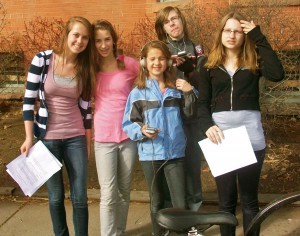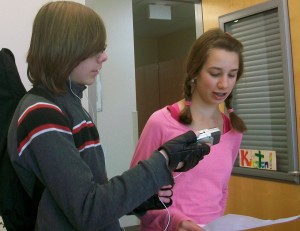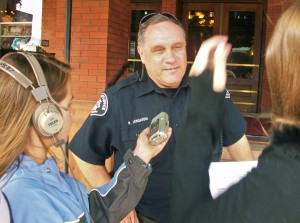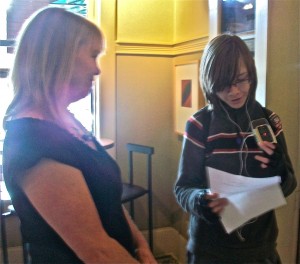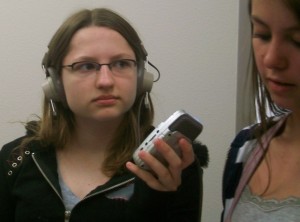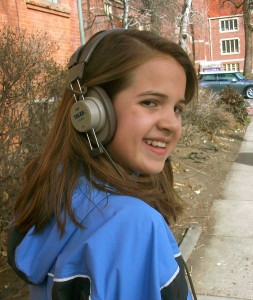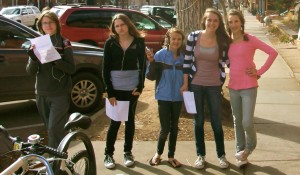Sometimes, people ask, “How do you make a radio story?” For a close look at the steps, let’s talk about the April Fool’s Day survey the Casey Middle School Students did about Decaf Soy Latte.
Step 1: Choose a Topic
. . . and, if needed, prepare a script. You want a very loose script if you’re doing an interview, so that it flows in a natural conversation. That kind of script is just to keep you from forgetting an important point. But some things need more structure. Here’s the script that Casey Middle School Students used for conducting their survey.
Hi. My name is ___________. I’m a student at Casey Middle School, and I’m helping KGNU conduct a survey that will broadcast on tomorrow morning’s news. Do you mind if I ask you the survey question?
(IF THEY SAY YES . . . ) The question is: “The City Council is thinking of choosing an official Boulder beverage. The top choice is an organic, decaf, soy latte (pronounced, LAH-tay). What do you think of this idea? (GET ANSWER) Do you have an alternate beverage to suggest? (GET ANSWER)
Thank you. The results of this survey will broadcast tomorrow on KGNU’s morning news, around 8:15. KGNU is at 88.5 FM, and on the web at kgnu.org.
Step 2: Gather Sound
. . . and, if needed, practice with a friend before doing your actual sound gathering. Try to pay attention to getting the mic close enough to the other person to gather good quality sound, and keep in mind that to do this, you generally have to get the mic much closer to the person than you would normally be. Think of the mic as an ice cream cone that’s just a hand-width away from the person you’re interviewing, so that they can be ready to take a bite if they want to. And remember to mic YOURSELF that closely when you ask someone a question. Also remember that some voices are soft and some are loud. For softer voices, hold the mic a little closer. All these things get better with practice.
But once you’re out there gathering sound, forget about perfect and just do your best. Try to find quiet places, out of the wind, and keep going when it comes to gathering sound. Also, be sure to “interview” whatever room you’re in. That is, get around 30 seconds of the natural sound of the room itself, so that you have some background sound you can blend in as needed to smooth things between your main sound tracks. If you’d like to hear what it’s like to gather sound,
Click here for raw sound (5 minutes)
This comes from the Casey Middle School journalists. You’ll hear lots of stuff that we don’t generally put on the air, meaning just talk, and background sound and so forth. That’s okay! It’s better to keep recording, because you never know when there’s some golden moment that otherwise you might have missed.
Step 3: Do a Rough Edit
The Casey Journalists did a great job interviewing students and teachers at their middle school, plus people out on Boulder’s Pearl Street Mall. It was a windy day, so we’re thankful that the Hotel Boulderado allowed them to come inside and interview people there (Student Teacher Mark helped the journalists find someone in charge to get permission to do some recording in the building) The students did what generally works the best for a good story. They gathered an hour of sound recording, which improved the chance that there would be plenty of interesting material to work with, for boiling down to a less-than-five-minute story.
The catch is, we asked them to do all this the day before the story would broadcast. This meant a quick turnaround for getting the story ready for KGNU’s Friday morning news show. That’s okay. These things don’t have to be perfect. But they DO need to get done, and my goal was to trim the sound to under 5 minutes. There are thousands of ways to choose sound, and everyone does it differently. This is a clue that an editor/producer has a lot of influence on what the final story will be! In my case, I chose segments that featured each of the five student journalists and provided a variety of responses. I listened quickly, for segments that caught my attention, made me smile or made me perk up my ears. I chose segments that did NOT have a lot of wind or hard-to-understand elements to them, but I didn’t worry if the sound was too quiet – that’s fixable.
I had around three hours in the evening free, so I decided to get a rough cut of the story ready before I went to bed, so I’d be refreshed and have a fresh ear for cleaning it up in the morning.
Here’s a quick look at part of the GarageBand Edit I did for creating the 5-minute rough segment.
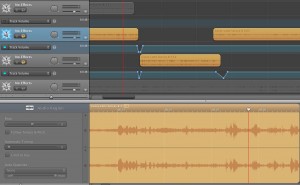 You need to know about GarageBand to understand details about this. But here are three things to notice.
You need to know about GarageBand to understand details about this. But here are three things to notice.
1. I’ve only pulled the sound I liked the best into these tracks, and I’ve left the sound I didn’t like as much in another place.
2. I’ve used 2 different “tracks” and arranged my favorite sound however I want. In other words, rather than just take the first sound I heard, I put it in an order that felt to me more like a story. Using two tracks made it easier to switch around between the segments that I chose.
3. Where the sounds blended well, I overlapped them just a tiny bit, trying to choose moments where it was ambient sound rather than talking, so that the listener would not notice an abrupt change between the sounds.
4. Where the sounds didn’t blend well between two tracks, I faded the sound down on the first track, and I faded the sound up on the next track, to reduce harsh jolts of new sound between the two tracks. As a hint, in general, it’s never good to have two voices run into each other in a sound piece. It’s best to have at least a normal breath (roughly half a second) between two voices. That’s a good rule of thumb to use when mixing different tracks of voices.
One thing I did NOT do yet was to adjust all the sound levels. That’s because, while it’s possible do to this in Garage Band, it’s really not very easy because it doesn’t show you visually where the sound is especially quiet and where it needs adjustment. I knew I’d be going into KGNU early in the morning the next day, where I could use Adobe Audition/Cool Edit, which is a sound editing program that makes it much easier to adjust sound volumes and do quick final edits. So I just stuck with a raw, rough edit that’s been trimmed from one hour to under 5 minutes.
Click Here for the the 4:39 rough edit.
Step 4. Final Clean-Up
It always helps to take a break from sound editing, then come back and do another listen. In this case, I knew I would HAVE to do this, because the sound levels were very uneven. That’s often the case when a variety of people are being interviewed, and a number of people are doing the interviews.
I waited until the wee morning hours (5:30 AM in this case), when I was at the KGNU studios and using Adobe Audition, a sound editing program that makes it easier to adjust sound levels precisely than Garageband does. Yes, it can be done on Garageband, but since I was able to use Adobe , why not? (Note for techies: Adobe and Garageband “read” sound files somewhat differently, so I had made sure to “export” my sound file for Adobe as either a .wav or an .mp3, which is readable by Adobe. )
Anyway, I listened to the whole file, balanced the sound levels, cleaned up some awkward spots and cleared out some ums and aws, and ended up with a short feature that was 30 seconds shorter than the first, rough edit.
Click Here for the 4:09 broadcast version.
Step 5. Add an Intro and an Outro, and put it in the lineup
Even when a radio piece is ready, you can’t just put it on the air. It needs a “frame” of explanation before and after, to help listeners have an idea about what they’re going to hear (that’s the “Intro,” which stands for “Introduction), and after the piece is done, something that sums up what the piece was about (that’s the “Outro” which stands for, well, “Outroduction,” I suppose). It’s also nice to arrange the radio piece so that it’s connected to something else that follows.
Click here for the full 20-minute newscast.
Click here for just the final, 9-minute April Fooly Segment.
In that final segment, you’ll hear a number of different parts. Some of them went well. Others could have been better. But that morning, I was under the gun a lot more than I expected, because there was a long, breaking news segment that had to be included, which meant all the timing had to be adjusted, and I didn’t do the math ahead of time, and I let the music breaks go to0 long and a bunch of other stuff (for instance, I didn’t write out the entire script, which meant my host narrations stumbled sometimes and rambled others) . . . anyway, here it goes . . . .
1. Music Break is generally 10 -30 seconds, to give a radio listener a break from news and some time to let the previous story soak in. In this instance, it had been a serious story about Japan and the nuclear leaks. The music gives some emotional space for switching to the more light-hearted topic of a decaf soy latte survey.
2. Host Intro is generally a less-than-1-minute (and often 30 seconds or less can be even better) introduction to what the topic of the next feature will be. In this case, the introduction just explains that The City of Boulder is thinking of choosing an official city beverage, and Casey Middle Students have helped conduct a survey to get citizen responses. Let’s listen in . . .
3. The actual feature broadcasts.
4. Host Outro. Host “outroductions” generally thank the person or people who produced the piece. In this case, the Outro also explained that the city of Boulder is NOT planning to designate soy lattes as the official city beverage, and so it’s been, well, a hoax. And then there’s a short mention of Sophia’s story about how to April Fool parents by putting Monopoly money in their wallets. I would have actually played Sophia’s explanation, but at this point, we were short of time for the morning news, so it had to be said fast, which is why it’s part of the host segment.
Click here for two student pranks.
5. Host Intro. Often, there’s a music break between one feature and the next. But at this point, we were very short of time for the morning news cast, and also, the next feature was about the history of April Fools Day. So after a short explanation, it was on to . . .
6. History of April Fool’s Day Feature – Where retired English Professor Mike Bell (who’s a KGNU Volunteer) gave a lovely account of April Fool’s Day pranks from many eras. Now, Mike’s explanations were lovely, but because of the breaking news we had to add to the morning lineup, we were about three minutes shorter on time than we had planned to be. I had already shortened up another prerecorded feature earlier in the morning. But now, Mike’s feature had at least two minutes to go! So I waited until he came to the end of a sentence, then I zipped down the volume on the recording and did another Outro, as if that was the full, total end of the story he had told.
To the listener, it probably sounded, well, okay. Though I like how he ended the longer version the best.
Click here for Mike Bell’s 6 1/2 minute interview.
So that’s how it goes.
If you’ve got questions or comments, send me a note! — Shelley the Radio Lady
This program was made possible in part through a grant from the City of Boulder Youth Opportunities Board.

